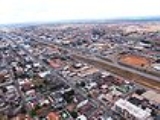
Vilhena
Encyclopedia
Vilhena is the easternmost municipality
in the Brazil
ian state of Rondônia
. Its population was 68,405 (2008) and its area is 11,519 km². It is the fifth-largest city in Rondônia state.
and Porto Velho
. Towns often would rise around these posts, Vilhena included.
On October 11, 1977, President Ernesto Geisel
endorsed the Law No. 6448, which break down Vilhena of Porto Velho. Being recognized as a city of Rondônia.
Municipality
A municipality is essentially an urban administrative division having corporate status and usually powers of self-government. It can also be used to mean the governing body of a municipality. A municipality is a general-purpose administrative subdivision, as opposed to a special-purpose district...
in the Brazil
Brazil
Brazil , officially the Federative Republic of Brazil , is the largest country in South America. It is the world's fifth largest country, both by geographical area and by population with over 192 million people...
ian state of Rondônia
Rondônia
Rondônia is a state in Brazil, located in the north-western part of the country. To the west is a short border with the state of Acre, to the north is the state of Amazonas, in the east is Mato Grosso, and in the south is Bolivia. Its capital is Porto Velho. The state was named after Candido Rondon...
. Its population was 68,405 (2008) and its area is 11,519 km². It is the fifth-largest city in Rondônia state.
History
In common with many other municipalities of Rondônia, Vilhena was started in the early twentieth century, around 1910, when Cândido Mariano da Silva Rondon built telegraph posts in the fields of the Plateau Parecis, linking several cities between CuiabaCuiabá
Under the Koppen climate classification, Cuiaba features a tropical wet and dry climate. Cuiabá is famous for its searing heat, although temperatures in winter can arrive sporadically at 10 degrees, indeed atypical, caused by cold fronts coming from the south, and that may only last one or two...
and Porto Velho
Porto Velho
Porto Velho is the capital of the Brazilian state of Rondônia, in the upper Amazon River basin. The population is estimated to be 426,558 people...
. Towns often would rise around these posts, Vilhena included.
Population growth
Migration from southern and southeastern regions provided a population boost in 1959 after the construction of highway BR-364, which connects the north with the rest of the country. The region's wealth of wood in the forest sites and a healthy climate attracted many permanent residents. In 1964 many migrants from all over the country were attracted to the region because the distribution of land to settlers by INCRA (National Institute of Colonization and Agrarian Reform).Emancipation
In the year 1969 on April 1, Vilhena becomes district capital of Porto Velho by decree No. 565. Vilhena at this time had about 160 homes, with an estimated population of 800. Simultanously the office of Civil Registry and the Court of Peace were established. The first administrator of the district of Vilhena was Mr. Gilberto Barros de Lima, who held this district post from March 1973 to June 1977. Several sawmills were started at this time.On October 11, 1977, President Ernesto Geisel
Ernesto Geisel
Ernesto Beckmann Geisel, was a Brazilian military leader and politician of German descent who was President of Brazil from 1974 to 1979.-Early life and family:...
endorsed the Law No. 6448, which break down Vilhena of Porto Velho. Being recognized as a city of Rondônia.

